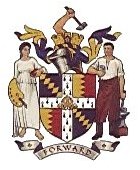 THE BIRMINGHAM COAT OF ARMS
THE BIRMINGHAM COAT OF ARMS
 THE BIRMINGHAM COAT OF ARMS
THE BIRMINGHAM COAT OF ARMS
When the Borough of Birmingham was incorporated in 1863 it adopted the
armorial bearings of the de Bermingham family (Lords of the Manor from the
Norman Conquest to 1532) as its Seal.
In 1889 when Birmingham was granted city status, it gained the right
to add supporters (figures) to the shield.
Minor adjustments were made in 1936.
Following boundary reorganisation in 1974 the Royal Borough of Sutton
Coldfield became part of the city. A new Coat of Arms was adopted in 1976.
The design included a bishop's mitre (commemorating the 16th century
Bishop Vessey) and the Tudor rose (marking Henry VIII's granting of a
city charter in 1528). Two distinct quarters appear on the shield.
The bend of lozenges appears on the shield of an effigy of a
de Bermingham Lord in St-Martins-in-the-Bull-Ring.
The Coat of Arms was granted by the College of Arms.
The City Council cannot authorise the use of the Arms other than for its own purposes.
Coat of Arms: Quarterly first and fourth Azure a Bend of five lozenges
conjoined Or second and third per pale indented Or and Gules
over all a Cross Ermine thereon a Mitre proper.
And for the Crest, on a Wreath of Colours Issuant from a
Mural Crown Or charged with a Rose Gules charged with another
Argent barbed and seeded proper a dexter Arm embowed the hand
holding a Hammer all proper.
Supporters: On the dexter side a Female figure (representing Art)
proper vested in Argent wreathed round the temples with Laurel Vert
tied by a Riband Gules holding in the sinister hand resting on the
shield a Book bound also Gules and in the dexter a Painter's Palette
Or with two Brushes proper and on the sinister side a Man habited as
a Smith (representing Industry) holding in the dexter hand resting
in the Shield a Cupel and in the sinister a Hammer resting on an
Anvil all proper.
Heraldry, or armoury to give it its more ancient name, has existed since
Biblical times. At first it was merely a decorative art, but later
developed as a useful method of recognising kinship and allegiance.
By 1100 AD, between the First and Second Crusades, it had become
an ordered and serious art. The earliest arms were adopted at will,
but by 1400 European sovereigns were granting insignia, by means of
letters patent, usually to nobility.
The practise spread from the warrior class to the Church,
artisan guilds, institutions and numerous municipal authorities.
In Great Britain, the heraldic office has survived to the present day.
In England heraldic authority is invested in the College of Arms,
which holds the view that no coat of arms can be assumed as
a matter of course. It must be confirmed by the College.
Argent, silver or white; azure, blue; bend, a band crossing the shield from dexter chief to sinister base; dexter, the right-hand side of the wearer; embowed, bent like a bow; gules, red; lozenge, diamond shape; mural, like a wall; or, gold; per pale, from top to bottom; proper, in natural colours; quarterly, by quarters in the shield in the following order 1st - dexter chief (wearer's top right), 2nd - sinister chief (wearer's top left), 3rd - dexter base (wearer's bottom left), 4th - sinister base; sinister, left hand side (of wearer); vert, green.